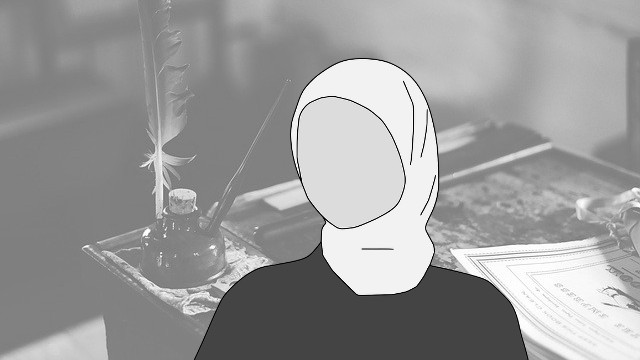The history that we read is not the history of the subaltern. On International Women’s Day, amid the hullabaloo of celebratory inbox messages let’s have a look at the real facts about the willful patriarchal, religious supremacist connivance of forgetting or excluding women from the mainstream discourse. What can better tell us this except how the Muslim women writers are excluded from syllabus?
The school curriculum is an important medium to teach children the lessons of gender sensitivity, gender equality, religious diversity and democratic values. But our androcentric, religious homogeneous syllabus is teaching children gender insensitivity and robbing of our future generation women role models.
The marginal presence of Muslim women writers in the textbooks of West Bengal Board of Secondary Education (WBBSE) and West Bengal Board of Madrasah Education (WBBME) are classic examples of this. From the fifth to the tenth standards the meagre presence of Muslim women writers in text books exhibit sheer marginalisation of Muslim women writers in West Bengal.
Here is the data:
TABLE -1 (Subject – Bengali, WBBSE)
| Class | Total Number of Lessons | Number of Women Writers | Number of Muslim Women Writers |
| V | 26 | 3 | 0 |
| VI | 28 | 1 | 0 |
| VII | 35 | 2 | 0 |
| VIII | 37 | 2 | 0 |
| IX | 29 | 4 | 1 |
| X | 29 | 2 | 0 |
TABLE – 2 (Subject – English, WBBSE)
| Class | Total Number of Prose and Poetry | Number of Women Writers | Muslim Women Writers |
| V | 12 | 1 | 1 |
| VI | 12 | 5 | 0 |
| Vll | 13 | 1 | 0 |
| VIII | 13 | 2 | 0 |
| IX | 12 | 2 | 0 |
| X | 8 | 2 | 0 |
TABLE – 3 (Subject – Bengali, WBBME)
| Class | Total Number of Lessons | Number of Lessons By Women Writers | Number of Lessons written by Muslim women writers |
| V | Same books of table number – 1 is followed | ||
| VI | 18+19( two text books) | 3+4 | 2+2 |
| VII | 20 | 4 | 1 (A complete book on the collection of Rokeya Shakhawat Hossain is being taught) |
| VIII | 20 + 20(Two text books) | 1+1 | 1 |
| IX | Same books of table number – 1 is followed | ||
| X | Same books of table number 1 is followed | ||
The WBBME follows the same text books of The WBBSE in English language teaching.
The process of willful forgetting causes an impression that there may not be available substantial Bengali Muslim women writers to be included. But the data is negating this impression. Even before partition there were many substantial women writers who enriched Bengali literature with their works.
Only Begum Rokeya, Sufia Kamal have got some attention. The writings of Khayarennesa, M Rahaman (to whom Kazi Nazrul Islam dedicated his poem ‘Bisher Banxi’) , M Fatema Khanam, Nurunnnesa Khatun ( she is considered the first Muslim novelist of Bengal) , Sayeda Khatun ( wrote two novels: ‘Niyantrita’ and ‘Maranbaran’), Fazlitunnesa, Mahamuda Khatun Siddiqua, Razia Khatun Choudhury, Samusnnehar Mahamud, have remained forgotten from our academic discourse, our textbooks. Their contribution to literary genres were not less than their Hindu sisters. But a patriarchal, religious framework guiding in designing curriculum have pushed them to the dungeon of oblivion.
The Muslims are often vitiated by attacking their conservativeness. The writings of the above mentioned Muslim women can counter the myth. Khayarennesa’s interest in the Swadeshi movement was quite noticeable. Her article on “Education and Swadeshi” was published in Nabannur. M Rahaman was so involved in anti-colonial struggles that according to her last wish a khadi cloth was put into her coffin after her death on December 20th 1926 (Source: Indian Journal of Gender Studies, 8:2,2001). She was a firm believer in unity between Hindu and Muslims. She was a regular contributor to Dhumketu whose editor was Kazi Nazrul Islam.
These Muslim women writers spoke out against the important issues like talaq also. Even the writings of Muslim women writers’ absence of present time in textbooks is quite conspicuous. The Muslim women writers who have written or are writting in English are also excluded. Seeing such less representation Akhtar (2008) wrote:
“Histories of literature usually dedicate a chapter on Muslim writers […]. This chapter would be slim in the books published in West Bengal and comparatively thicker in those published in Bangladesh, although Bengali literature in this period was enriched by the contributions of both Hindu and Muslim writers […]. Muslim writers, irrespective of whether they were male or female, it goes without saying, have been largely ignored by most literary histories.” [Source :”Marginalisation of Muslim Writers in South Asian Literature: Rokeya Sakhawat Hossain’s English Works”, Md. Mahmudul Hasan]
By marginalising Muslim women writers from the mainstream discourse of the educational system, students are also being made alienated. By going through their works students could have known the social, economical mindset of Muslim women writers of their respective time. As writers of the Indian subcontinent, the learners will get more assimilated with their works.
So their alienation, their exclusion from the textbooks, is a ploy to present colonial, patriarchal, religiously singular textbooks to the students who are supposed to be the future of our fractured democracy.
Moumita Alam is a non-conformist. She writes about the exploitation of the marginalised. As a teacher and a poet, her pen flares up against all forms of oppression. She loves to read when not writing and she thinks critically about the socio-political aspects of life. Keen to change the society to an egalitarian one for the present have-nots.

